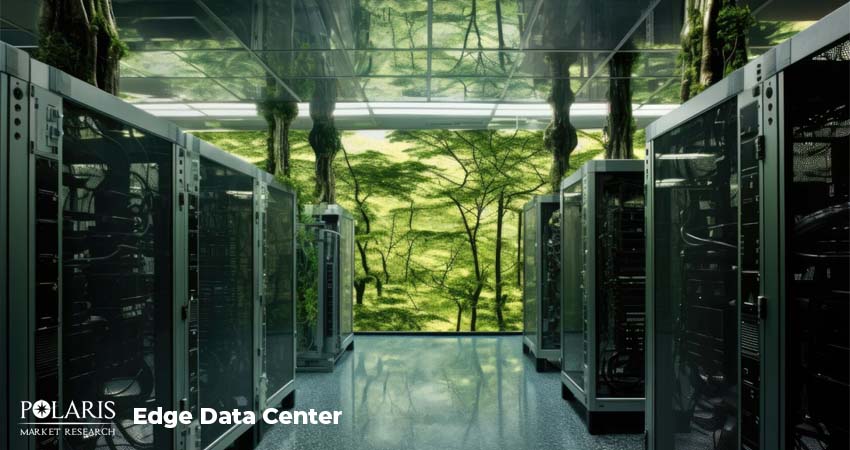How Edge Data Centers Are Shaping the Future of Computing?
The internet is a vast network of interconnected networks connecting computers and other devices across the globe. At its heart, data centers are crucial infrastructure necessary for processing and storing information at lightning speed. Typically, data centers are located in remote locations as these areas have more available land and may offer natural cooling as compared to urban and suburban regions.
But what if these data centers were scattered across the globe, closer to the end users they serve? Let’s dive deep into the world of edge data centers, which are rapidly transforming the future of technology. Along our journey, we’ll also take a look at the top companies that are driving the edge computing revolution.

What is Edge Data Center?
An edge data center is a small, localized data center that’s located close to the population it serves. It enables a wide range of next-gen applications and provides its customers with the benefit of reduced latency, higher security, and greater control over data. Edge data centers optimize data distribution and user experience by supporting content delivery networks, IoT devices, and autonomous vehicles. In many instances, these data centers usually share a connection with a large data center or several other data centers for apt functioning.
Characteristics of Edge Data Centers
Most edge data centers share similar key characteristics. These include:
Location: Edge data centers are typically located near the areas they serve.
Size: An edge data center has a much smaller footprint, while having the same components as a traditional data center.
Data Type: These data centers typically handle mission-critical data and information that requires low latency.
Deployment: An edge data center is typically connected to a large, central data center. In other instances, it may be a part of a network of edge data centers.
Working of Edge Data Centers Explained
An edge data center plays the role of a connection between multiple networks, facilitating information exchange between the network and a requesting device. With edge data centers, users can seamlessly access localized computing resources, especially for applications like machine learning and edge computing.
These data centers are located near the data source. Typically, they make use of edge caching, which are software or hardware-based components that store data temporarily to reduce computing response time. Often, these components take the form of micro mobile datacenters (MDCs), which are modular systems designed to maintain network uptime and manage security. Further, MDC components may include fog computing, which is a form of distributed computing architecture that uses cloud and data storage infrastructure to move data to preferred areas.
Top Use Cases of Edge Data Centers
Here are some of the top use cases of edge data centers:
Autonomous Vehicles: With edge data centers, self-driving cars can collect, process, and share data in real-time.
Smart Cities: Edge computing resources facilitate real-time collection and analysis of data on traffic, utilities, and infrastructure.
Manufacturing: Edge data centers and other data center solutions can equip industrial IoT devices with data storage and computing capabilities to improve energy efficiency and perform better predictive maintenance.
Financial Institutions: Edge data centers can reduce the latency for high-volume banking firms, improving the execution speed of trading algorithms.
Who Makes Edge Data Centers?
The edge data centers market has the presence of several established players. These players have adopted strategic partnerships and product developments to cater to the evolving demands for edge data centers. Here’s a look at the top companies offering edge data centers:
AWS
Amazon Web Services (AWS) is a leading provider of on-demand cloud computing platforms and APIs for organizations worldwide. Along with a comprehensive suite of cloud services, the company offers edge services that allow users to deploy APIs and tools closer to their endpoints. The edge services by AWS are ideal for organizations that need real-time data processing and analysis.
Google Cloud
Google Cloud Platform is a suite of cloud computing services offered by Google. The service offering includes computing, data storage, data analytics, and machine learning, alongside a range of management tools. Google Distributed Cloud is an advanced solution that extends the reach of Google Cloud into regional data centers. That way, businesses can take advantage of Google’s advanced cloud centers without having to rely on a centralized data center.
NVIDIA
NVIDIA is a US-based technology company that designs and supplies graphic processing units (GPUs) and application programming interfaces (APIs) for AI, autonomous vehicles, and robotics. NVIDIA’s EGX Edge Computing Platform allows organizations to scale, manage, and deploy edge computing solutions across their distributed networks. Also, the company offers the NVIDIA AI-on-5G platform for simplifying the deployment of AI applications over 5G edge networks.
Dell
Dell is a US-based technology company that offers computers and related products and services. The company is well-known as a hardware provider in the server market. Dell offers the NativeEdge edge software platform designed for simplifying, securing and optimizing edge deployments across several sectors. Also, the company has a unified management interface for its edge computing hardware.
IBM
International Business Machines Corporation (IBM) is an American multinational technology company that offers hardware and software products. With a cloud-based approach to edge computing, it promotes the use of IBM management tools and services for better unification of the edge with a vision for hybrid and multi-cloud services. Also, IBM has adopted several strategic initiatives to boost its product offering. For instance, in January 2024, IBM announced a strategic collaboration with American Tower to enhance edge cloud services for enterprises.
Besides these, other leading companies offering edge data centers are Schneider Electric, Cisco, Rittal, Equinix, Vapor IO, Siemon, and SBA Edge.
Enabling Real-time Applications
To conclude, edge data centers are transforming the way we interact with technology. By bringing computing closer to data sources, these data centers reduce latency and enable several real-time applications. With the rising prevalence of connected devices and growing demand for real-time processing, edge data centers will play an increasingly pivotal role in the realm of technology.


